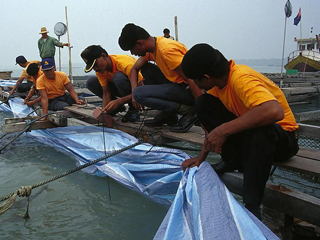Protective Strategies

Oil spilled at sea will often reach the land and threaten coastal resources. It may be possible to protect some of these resources by the strategic deployment of booms. Other measures may also be appropriate, such as closing water intakes to industrial plants or coastal lagoons.
Highest priority should be given to protecting coastal resources which are particularly sensitive to oil pollution and which can be boomed effectively. These often include fish and shellfish farms, industrial water intakes, leisure facilities such as marinas, and environmentally sensitive areas, such as bird colonies. Whilst some sites will be relatively easy to protect, others such as marshes, mangroves and amenity beaches are often too extensive for booming to be practical.
Where conditions permit, alternatives to traditional protective strategies may prove effective. In particular, a variety of strategies are available that may help protect mariculture facilities, including the relocation of sea cages, pens or long-lines or the transfer or early harvest of stock.
With sufficient warning, it may be possible to move mobile marine assets eg recreational and commercial vessels, floating pontoons and mooring tackle. Although there may be costs associated with moving assets, they are likely to be less than the costs of cleaning if contaminated by oil.
Flotsam and jetsam may also be removed before any oil arrives so that the amount of oiled debris for disposal is greatly reduced.
An oil spill may threaten important coastal habitats for birds eg sand flats and salt marshes. In order to reduce the risk of birds becoming oiled, it may be considered appropriate to use bird hazing ('bird scaring') techniques. These include auditory (eg horns and cannons), visual (eg scare tape and flashing buoys), and exclusion (eg netting) techniques. The most effective option will be dependent on the nature of the habitat and the birdlife at risk.
